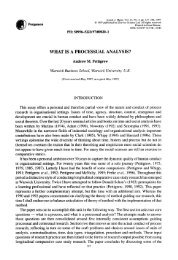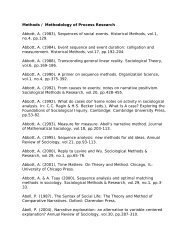Designing Process Research Studies - Process Research Methods
Designing Process Research Studies - Process Research Methods
Designing Process Research Studies - Process Research Methods
Create successful ePaper yourself
Turn your PDF publications into a flip-book with our unique Google optimized e-Paper software.
<strong>Designing</strong> <strong>Process</strong> <strong>Research</strong> <strong>Studies</strong>:AOM <strong>Process</strong> <strong>Research</strong> PDW, Atlanta 8/12/06• Basics of <strong>Process</strong> <strong>Research</strong>• <strong>Designing</strong> Field <strong>Studies</strong>• Analyzing <strong>Process</strong> Data• Exercise: Design a processstudyDownload fromhttp://www.processresearchmethods.org/PDW06.htmVan de Ven, Engaged Scholarship, chapter 7,Oxford U. Press, forthcoming 2007.Andy Van de VenU. Of MinnesotaFurther reference:Poole, M.S., Van de Ven, A.H., Dooley, K., & Holmes, M.Organization change and innovation processes:Theory and methods for research, Oxford U. Press, 2000Basics in <strong>Designing</strong> <strong>Process</strong> <strong>Research</strong>1. Define the meaning of process:• A logic that explains a causal relationship• A category of concepts or variables• A narrative of how things change over time2. Clarify theory of process (vs. variance theory)• process vs. variance theories• life cycle, teleology, dialectic, & evolution process theories3. Adopt a process vocabulary• simple, multiple, cumulative, conjunctive & iterativeprogressions4. Design research to observe and analyze process1
Steps & Decisions in <strong>Designing</strong> <strong>Process</strong> StudyKey Step Key Decision(s) Suggestions1. The topic What is the research question or How/why an organization changes?problem?How a change process unfolds?2. The research question Variance or process research? Variance for causal questions<strong>Process</strong> is geared to how questions3. Frame of reference Who’s viewpoint is featured?What is the researcher’s role?Observe change process from aspecific participant’s viewpoint4. Mode of inquiry Sound general argument orgood particular story?General explanations – causal theoriesParticular understanding - narratives5. Conceptual model One or more models/stories? Compare plausible alternative modelsWhich ones?6. Observational method Real-time or historical Observe before outcomes are knownobservations?7. Field research design How design the field research? Develop parallel, synchronic, andDiachronic research design8. Sample diversity Homogeneous or heterogeneous? Compare the broadest range possible.Compare different viewpoints.9. Sample size Number of events and cases? Focus on number of temporalintervals and granularity of eventsSteps & Decisions for Analyzing <strong>Process</strong> DataKey Step Key Decision(s) Suggestions1. Developing process What concepts or issues will you Begin with sensitizing conceptsconceptslook at?and revise with field observations2. Defining incidents& eventsWhat activities or incidents areindicators of what events?Incidents are observations, eventsare unobserved constructs3. Specifying anincidentWhat is the qualitative datum? Develop decision rules to bracketor code observations4. Measuring an What is a valid incident? Ask informants to verify incidentsincident5. Identifying events What strategies are available totabulate and organize field data?Apply a mix of qualitative andquantitative data analysis methods6. Developing theprocess theoryHow move from surfaceobservationsto a process theory?Identify characteristics ofnarrative theory2
Design a <strong>Process</strong> Study Exercise• Design a process study to examine yourquestion/problem.• Consider the issues in the handout whendesigning your study.• What design issues did you find difficult andrequire further discussion?Worksheet for <strong>Designing</strong> a <strong>Process</strong> <strong>Research</strong> StudyIssues<strong>Process</strong> Study Design1. State your processresearch question2. Whose viewpoint isfeatured?3. How define process- as variable or event?4. What process theoriesdo you examine?5. Deductive, inductiveOr abductive?6. Real-time or historicalobservations?7. What units examinedwithin & over time?8. Sample diversity inwhat dimensions?9. Sample size:# of events and cases?Measurement & Analysis1. Define yourprocess concepts.2. Define indicators ofprocess concepts3. What is an incidentor event (a datum)?4. How measure & verifyincidents?5. How tabulate andorganize process data?6. How develop a processTheory or narrative?Your <strong>Process</strong> <strong>Research</strong> Study3
Slides Illustrating Stepsin <strong>Designing</strong> <strong>Process</strong> <strong>Studies</strong>For display as questions or issues arise<strong>Process</strong> <strong>Research</strong> Definitions• Meaning of process:1. A logic that explains a causal relationship2. A category of concepts or variables3. A narrative of how things change over time• Change: an observed difference in form, quality orstate over time in an entity.• Development: the progression of change eventsover the duration of an entity’s existence• <strong>Process</strong> Theory: An explanation of an observedprogression of change events in terms ofgenerating mechanisms that cause events tohappen in the world and the circumstances whenthey operate (Tsoukas, 1989).4
EVOLUTION (Competitive Change) DIALECTIC (Conflictual Change)MultipleEntitiesUnit ofChangeVariation Selection RetentionPopulation ScarcityEnvironmental SelectionCompetitionLIFE CYCLE (Regulated Change)4 (Terminate)ThesisAntithesisConflictPluralism (Diversity)ConfrontationConflictSynthesisTELEOLOGY (Planned Change)DissatisfactionSingleEntityStage 3(Harvest)Stage 2(Grow)Stage 1(Startup)ImplementGoalsSet/EnvisionGoalsSearch/InteractPrescribedImmanent ProgramRegulationCompliant adaptationMode of ChangePurposeful enactmentSocial constructionConsensusConstructive<strong>Process</strong> Models of Organization ChangeNote: Arrows on lines represent likely sequences among events, not causation between events.Source: Van de Ven & Poole, Explaining Development and Change in Organizations, AMR, 1995.Variance<strong>Methods</strong>EpistemologyApproach IVariance study of change in organizationsCausal analysis of independent variablesexplaining change (dependent variable)Newtonian view of timeApproach II<strong>Process</strong> study narrating sequence ofchange events in organizationApproach IVVariance study of process patternsQuantitative analysis of event time series:Markov, time series, event history, &nonlinear complex adaptive systemsTime is a variable of change processApproach III<strong>Process</strong> study narrating emergentorganizing activities<strong>Process</strong><strong>Methods</strong>Progressions of change (stages, cycles, etc)In the development of org. entityQualitative narrative interpretation ofcomplexity metaphorTransaction or event-based view of timeSocial construction view of timeA noun, a thingOrganizationalOntologya verb, a processAlternative Approaches for Studying Organization ChangeFrom Van de Ven and Poole, “Alternative Approaches for Studying Organizational Change,” Organizational <strong>Studies</strong>, 2005.5
Variance and <strong>Process</strong> EpistemologiesLawrence MohrVARIANCE APPROACHFixed entities with varying attributesExplanations based on necessary andsufficient causalityExplanations based on efficientcausalityGenerality depends on uniformityacross contextsTime ordering among independentvariables is immaterialEmphasis on immediate causationAttributes have a single meaning overtimePROCESS APPROACHEntities participate in events and maychange over timeExplanations based on necessarycausalityExplanations based on final, formal, andefficient causalityGenerality depends on versatility acrosscasesTime ordering of independent events iscriticalExplanations are layered andincorporate both immediate and distalcausationEntities, attributes, events may changein meaning over time6
Bruner’s Two Modes of ThoughtLogico-Scientific ModeNarrative ModePurposeDevelop and test a theory thatexplains the causes orconsequences of a generalphenomenon in its context.Develop a plausible storythat interprets meaning to aparticular experience orsequence of eventsMethodLogical “if-then” propositionsthat derive testable hypothesesamong variables in specifiedcontextPlot linking intentionalactions of characters in inevents and settings.Discourse:Triggers assumptions,Is reflexive, andopen to multiple viewsEvaluationCriteriaValid argumentEmpirical truthBoundary conditionsVerisimilitudeA good storyReflexiveOpen to multiple viewsJerome Bruner(1915 - )Narrative Features of <strong>Process</strong> Theory• In narrative theory, the the story includes morethan just event sequence. A process theoryshould include:• Sequence in Time• Focal Actor(s)• Narrative Voice• Evaluative Frame of Reference• Indicators of Content and ContextBrian Pentland, “Building <strong>Process</strong> Theory with Narrative: Fromdescription to explanation,” Academy of Management Review, 24,4 (1999): 711-724.7
Narrative Positions of Voice & PerspectiveMary Jo Hatch, “The Role of the <strong>Research</strong>er: An Analysis of narrative position in organization theory,”Journal of Management Inquiry, 5, 4, December 1996, p. 362.Barley’s Field <strong>Research</strong> DesignBarley, S (1990) “Images of Imagining: Notes on Doing Longitudinal Field Work,” Organization Science, 1, 226.8
Typology of <strong>Process</strong> <strong>Research</strong> DesignsSource: Poole, et al (2000) Organizational Change and Innovation <strong>Process</strong>es: Theory and<strong>Methods</strong> for research. New York: Oxford Univ. Press.9
A Sample Event Data Entry FormDate:__________ Data Entry Forms Event #: ______Event:_________________________________________________________________________________________________________________________Observation: _________________________________________________________________________Source: ____________________________________2. Data Entry FormsKeywords: __________________________________A Sample Event ReportNumber: 38 Date: 02/01/77Event: University of Melbourne approaches 3M on a joint venture todevelop and manufacture CI. News of the development of a"bionic ear" triggers interest of executives at 3M.Observ: The relationship was not established, and 3M decides topursue the "bionic ear" idea separately.Number: 41 Date: 12/15/77Event: 3M evaluates U. of Melbourne, Australia proposal for the"bionic ear." A report to 3M executives states the project isa promising business opportunity. However, exclusive rightsand patent protection is reported as unclear.Observ: On the surface the project is very promising -- the US marketpotential using $ 1000 device (conservative) is $ 1000 mm. The deviceis an emerging technology, I am not aware of any publishedon-going research in this type area. (As with heart pacers, the firstcompany in the market can dominate). There is a good fit with existing3M technology. On the minus side, I have some doubts about the patentprotection. The Australian proposal does not indicate a strong position.There is also the problem with the distance involved and the proposalis rather vague about exclusivity after investments by 3M.10
Existing Event Data FileDays Event Observation Source KeywordsHouse & Doyle in Los The event was publishedin W.F. House01/01/77 ASHA, May 1985 House,Angeles conduct theAcademicians,1st cochlear implant and K.Berliner’s,in the U.S. by implantinga limited # Progress & Persp-“Cochelar Implants:transactionof patients using ectives,” Annals ofoutcomepositivesingle electrode dev. Otology & Rhinol.1982, p. 1-124.Added Columnsicirpetrciceop om0 0 0 1 0 0 1 0More Events11
Langley, A. (1999) “Strategies for Theorizing From <strong>Process</strong> Data,” AMR, 24, 1, p. 696.12
Example of Visual Mapping Strategy in CIP CaseSource: Van de Ven, Polley, Garud & Venkataraman, The Innovation Journey, NY: Oxford, 1999.Example of Temporal Bracketing Strategy in CIP CaseSource: R. Garud & A. Van de Ven, “An Empirical Evaluation of the Internal Corporate Venturing <strong>Process</strong>,”Strategic Management Journal, 13 (1992): 93-109.13
Example of 3DGraphing ofEvent Sequences14
eeeeeeeeee e e10224312 even15








